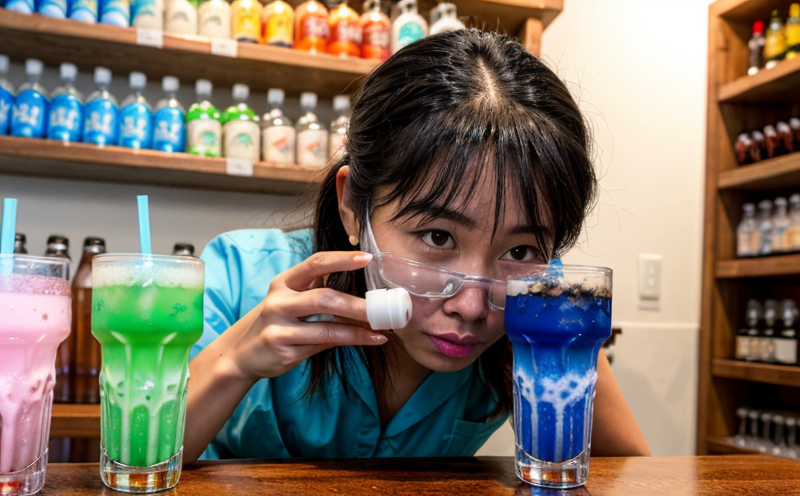AOAC 2006.06 Yeast and Mold Testing in Juices
The AOAC International Method 2006.06 is a widely recognized standard for the detection of yeast and mold species in beverages, including juices. This method ensures consistent and accurate microbiological testing, which is crucial for maintaining product safety and quality.
Yeast and mold are common contaminants that can affect the taste, shelf life, and overall consumer acceptability of juice products. The presence of these microorganisms can lead to spoilage, off-flavors, and potential health risks if not properly controlled during processing. AOAC 2006.06 provides a reliable means to monitor and control such contaminants.
The method involves the use of selective media that targets yeast and mold growth while minimizing interference from other microorganisms. This selective environment allows for accurate enumeration of yeast and mold colonies, which are then identified based on morphological characteristics or through biochemical tests.
Accurate quantification is essential to ensure compliance with regulatory standards such as those set by the FDA (Food Safety Modernization Act) and EU regulations. Regular testing helps manufacturers maintain a safe product while also enhancing their reputation for quality control.
The AOAC 2006.06 protocol uses a series of steps designed to extract yeast and mold from juice samples, followed by incubation on specific media. After growth has been observed, colonies are counted and identified using standard microbiological techniques. This process ensures that any potential contaminants are detected early in the production cycle, allowing for prompt corrective action if necessary.
For quality managers responsible for ensuring product safety and compliance with international standards, this method offers a reliable tool to monitor yeast and mold levels in their products. Compliance officers can use these test results as part of their risk assessment processes, while R&D engineers may employ them during development stages to optimize production methods that minimize contamination risks.
From an industrial perspective, maintaining consistent quality is key to competitive success in the beverage industry. By adhering to recognized standards like AOAC 2006.06, companies demonstrate their commitment to producing safe and high-quality products which can help build trust with consumers.
Benefits
Implementing AOAC International Method 2006.06 brings several advantages for beverage manufacturers:
Consistent accuracy in detecting yeast and mold species, ensuring product safety.
Reputation enhancement through compliance with international standards.
Prompt corrective actions when contamination is detected early during production.
Supports regulatory requirements set by agencies like the FDA and EU.
In addition to these direct benefits, adherence to this method also contributes positively towards maintaining consumer trust and satisfaction. By consistently meeting high standards for microbiological safety, companies can ensure that their products meet or exceed expectations, thereby fostering long-term customer loyalty.
For those involved in quality assurance processes, the AOAC 2006.06 protocol provides a robust framework upon which to build comprehensive testing programs aimed at maintaining superior product quality across all stages of production.
International Acceptance and Recognition
AOAC International Method 2006.06 is recognized globally for its effectiveness in detecting yeast and mold species in beverages, including juices.
This method has been adopted by various countries and regulatory bodies worldwide due to its reliability and precision.
It is specifically validated for use in the context of ensuring compliance with international food safety standards.
The method's widespread acceptance among manufacturers ensures consistent results across different geographical locations, facilitating global trade and collaboration.
Given its broad applicability and robust methodology, AOAC 2006.06 serves as a cornerstone for maintaining food safety standards globally. Its international recognition underscores the importance of rigorous testing practices in safeguarding public health and enhancing consumer confidence.
Competitive Advantage and Market Impact
Adopting AOAC 2006.06 can provide significant competitive advantages for beverage manufacturers:
Demonstrates a strong commitment to product safety and quality, enhancing brand reputation.
Ensures compliance with international food safety standards, reducing the risk of recalls or legal actions.
Promotes trust among consumers who value transparency and adherence to high standards.
Facilitates smoother trade by meeting regulatory requirements in multiple markets simultaneously.
Beyond these immediate benefits, incorporating such a stringent testing protocol into one's operations can serve as an effective differentiator from competitors. In today’s highly competitive market, maintaining superior product quality is critical for gaining and retaining market share. By embracing AOAC 2006.06, companies not only meet but often exceed expectations set by regulatory bodies, thereby positioning themselves favorably against rivals.
Moreover, the ability to consistently produce safe and high-quality products fosters strong relationships with suppliers and customers alike. This can lead to increased sales opportunities as well as reduced operational costs associated with potential issues arising from non-compliance or recalls.





